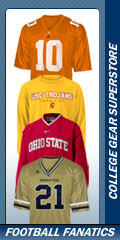 |
| SouthernCollegeSports.com |
| CONTACT SCS.com |
| SCS.com STORE |
| HOOPS FEATURES |
| TV Listings |
| HOOPS COLUMNS |
| Daniel |
| HOOPS LINKS |
| Live Scoreboard |
| Conference Standings |
| Top 25 Polls |
| FOOTBALL FEATURES |
| Free Pick'Em Contest |
| FOOTBALL COLUMNS |
| David |
| FOOTBALL LINKS |
| Live Scoreboard |
| Conference Standings |
| Top 25 and BCS Polls |
| Statistics |
| ABOUT US |
| The Work Force |
| Site Developed by AdcockDesign.com |
OFFENSE VS SAFETY: DO ALUMINUM BATS NEED TO GO?
May 1, 2007
Ryan, SCS.com Staff Writer
Contact Ryan
 Ping, it is the sound of an aluminum bat and a sound that goes hand and hand with high school as well as college baseball. The aluminum bat has several advantages offensively for the sport. However with those advantages also come a disadvantage for pitchers. An increasing number of pitchers are getting injured, or worse, due to the strong recoil of the ball off of an aluminum bat. Should there be a change from aluminum to wood in college and high school baseball?
Ping, it is the sound of an aluminum bat and a sound that goes hand and hand with high school as well as college baseball. The aluminum bat has several advantages offensively for the sport. However with those advantages also come a disadvantage for pitchers. An increasing number of pitchers are getting injured, or worse, due to the strong recoil of the ball off of an aluminum bat. Should there be a change from aluminum to wood in college and high school baseball?
The aluminum bat was first introduced some 30 years ago in the collegiate and high school level of baseball. Over the years, improvements have been made to the aluminum bats, making the bats hit longer and lighter. This increased bat speed and power of the bat has increased the offensive aspect of baseball on the amateur level, however it has also become an unnecessary risk to players' safety in the field.
Pitchers were hurt statistically with the introduction of the aluminum bat when it first came out, but improvements to the aluminum bat in the past thirty years have drastically increased the occurrences of pitchers getting hurt physically as well. The velocity of the ball off of a metal bat has increased the risk of injuries to pitchers who have a reduced reaction time due the increased velocity.
Some programs across the country have voluntarily made the switch back to the wooden bats due to the safety issues that the bats bring, although it is still a very minimal number that have gone back to playing with wood bats. There have even been instances where rules have required the switch to wood bats, like in North Dakota. The state made the decision to have all high school teams switch to wooden bats following the death of pitcher Brandon Patch.
Patch, a pitcher for the for the American Legion Class AA Miles City Mavericks, was struck by a line drive in the fifth inning one day and died that evening at 1 AM in July of 2003. Patch, who was 18 at the time of the accident, was struck in the side of the head after a line drive from an aluminum bat hit the vulnerable pitcher. How often pitchers are hit is not known due to the fact that there is no tracking of such a number.
I remember growing up in Gainesville, going to Gator games and watching deep shots out of the park off of the powerful aluminum bats year after year. One day that sits a little fonder in my memory is when the Gators played in-state rival Miami in, I believe, 1992. Marc Valdes was on the mound for the Gators; it was the first inning when Marc threw to a Hurricane batter. Ping! And with a blink of an eye, the ball hurled directly back at Marc, hitting him in the knee. Luckily Marc was only hit in the knee, and he left the game with an injury and was able to return to his next appearance in the pitching rotation. I thought to myself, a couple inches higher and it could have been much worse, as Marc did not have a chance to put his glove up to block the blow.
Near-misses like this happen all across the country every weekend, and the only remedy is to make the switch from aluminum to wood bats. Yes, wood bats are not as strong as aluminum bats and tend break or crack easily compared to the aluminum bats. The breaking of these bats brings an extra expense to programs and for high school players that purchase their own bats, which can put the players in a crunch financially. An aluminum bat, on the other hand, hardly ever breaks and normally has a life of 1 to 2 years. But to reduce the risk of another fatality on the field as well, as the countless injuries to high school and college players, the switch need to be made back to wood bats.
A change needs to come for all and needs to be passed down by the NCAA as well as NHSAA. The reason it needs to come from above is that if a school makes a stand and decides to make the move individually from aluminum to wood, the disadvantage is almost something a team can not overcome. A team playing with aluminum bats going against a team with wooden bats is going to hold an extra advantage. Not many are willing to make the change on their own.
Just this past week, the City Council in New York City banned the use of all metal bats in high school baseball starting this fall. The metal bats were outlawed based on the greater velocity of the ball that the bat produces and increased risk of injuries due to the reduction of reaction time. The ban could lead the way for others to follow with similar bans across the country to follow. However it appears that that would not be the case due to the strong opposition the ban in New York received from politicians and leagues.
It seems that for now, most leagues and programs are in a reactive mode in terms of changing from metal to wood. That is, leagues do not bring the topic up until a player is seriously injured, or in rare occurrences, killed by a line drive from a metal bat. Leagues across the country need to take a proactive stance and change to wood bats, changing not due an injury, but due to the potential of one.

|
SCS.com STORE
|
| ITEMS OF INTEREST |
| Write for SCS.com |
| In the Media |
| Player Testimonials |
| Audio Clip Archive |
| Team Addresses |
| Free Audio Links |
| D-I FB Location Map |
| Related Links |
| NCAA Autographs |
| SCS.com Archives |
| Advertise With Us |
| CONFERENCES |
| ACC |
| Big East |
| Big Ten |
| Big XII |
| Conference USA |
| MAC |
| Mountain West |
| PAC 12 |
| SEC |
| Sun Belt |
| WAC |
| [MORE] |
| CHRIST IN SPORTS |
| FCA.org |
| TheNCCAA.org |
| Athletes in Action |
| MoreThanWinning |
| Upward.org |
| Place your ad here. Contact SCS.com for more info. |
| Copyright © 2004-2009 SouthernCollegeSports.com. All rights reserved. This website is an unofficial and independently operated source of news and information not affiliated with any school, team, or league. |